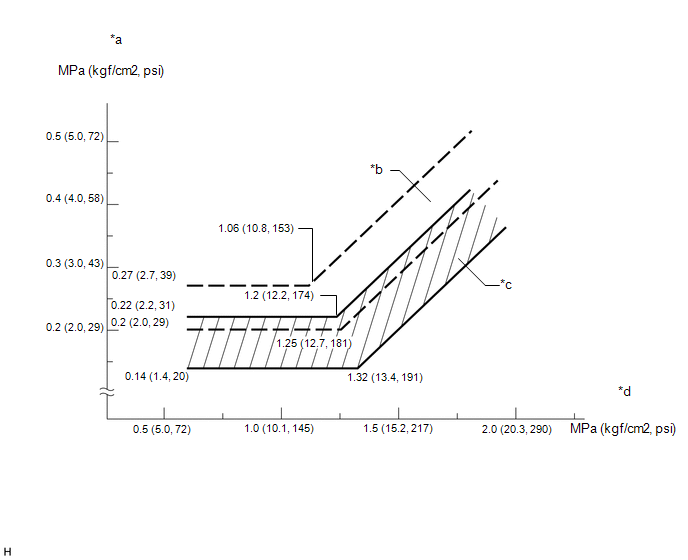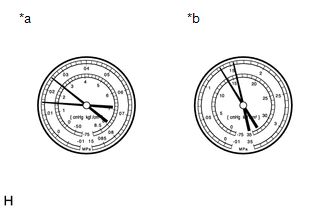Toyota Tacoma (2015-2018) Service Manual: On-vehicle Inspection
ON-VEHICLE INSPECTION
PROCEDURE
1. INSPECT REFRIGERANT PRESSURE
(a) This method uses a refrigerant recovery unit set to locate problem areas. Read the refrigerant pressure when the test conditions are established.
Test conditions:
- Temperature at the air inlet with the air recirculation switch set at RECIRC is 30 to 35°C (86 to 95°F).
- Engine is running at 1500 rpm.
- All doors are fully open.
- Blower speed control switch is set to HI.
- A/C switch is on.
Gauge readings (Reference):
 Text in Illustration
Text in Illustration
|
*a |
Pressure on low-pressure side |
*b |
Blower HI Zone |
|
*c |
Blower LO Zone |
*d |
Pressure on high-pressure side |
|
(1) Normally functioning refrigeration system. Gauge Reading:
|
|
(2) The A/C system periodically changes between normal and improper function due to moisture in the refrigerant system.
 Text in Illustration
Text in Illustration
|
*a |
Low Pressure Side |
*b |
High Pressure Side |
|
Symptom |
Probable Cause |
Diagnosis |
Corrective Action |
|---|---|---|---|
|
During operation, pressure on low pressure side cycles between normal and vacuum |
Moisture in refrigeration system freezes at expansion valve orifice, causing temporary stop of cycle. However, when melted, normal state is restored. |
|
|
(3) The A/C system does not function effectively due to insufficient refrigerant.
 Text in Illustration
Text in Illustration
|
*a |
Low Pressure Side |
*b |
High Pressure Side |
|
Symptom |
Probable Cause |
Diagnosis |
Corrective Action |
|---|---|---|---|
|
Gas leakage from refrigeration system |
|
|
(4) The A/C system does not function effectively due to poor circulation of the refrigerant.
 Text in Illustration
Text in Illustration
|
*a |
Low Pressure Side |
*b |
High Pressure Side |
|
Symptom |
Probable Cause |
Diagnosis |
Corrective Action |
|---|---|---|---|
|
Refrigerant flow obstructed by dirt in condenser |
Condenser clogged |
Replace condenser |
(5) The A/C system does not function or functions intermittently because the refrigerant does not circulate.
 Text in Illustration
Text in Illustration
|
*a |
Low Pressure Side |
*b |
High Pressure Side |
|
Symptom |
Probable Cause |
Diagnosis |
Corrective Action |
|---|---|---|---|
|
|
Refrigerant does not circulate |
|
(6) The A/C system does not function effectively due to the system being overcharged with refrigerant or insufficient cooling of the condenser.
 Text in Illustration
Text in Illustration
|
*a |
Low Pressure Side |
*b |
High Pressure Side |
|
Symptom |
Probable Cause |
Diagnosis |
Corrective Action |
|---|---|---|---|
|
Pressure extremely high on both low and high-pressure sides |
|
|
|
(7) The A/C system does not function due to air in the refrigeration system.
CAUTION:
The low-pressure piping may be very hot and cause serious burns.
NOTICE:
These gauge indications occur when the refrigeration system opens and the system is charged with refrigerant without vacuum purging.
 Text in Illustration
Text in Illustration
|
*a |
Low Pressure Side |
*b |
High Pressure Side |
|
Symptom |
Probable Cause |
Diagnosis |
Corrective Action |
|---|---|---|---|
|
Air in refrigeration system |
|
|
(8) The A/C system does not function effectively due to an expansion valve malfunction.
 Text in Illustration
Text in Illustration
|
*a |
Low Pressure Side |
*b |
High Pressure Side |
|
Symptom |
Probable Cause |
Diagnosis |
Corrective Action |
|---|---|---|---|
|
Problem with expansion valve |
|
Replace expansion valve |
(9) The A/C system does not function due to a defective compressor.
 Text in Illustration
Text in Illustration
|
*a |
Low Pressure Side |
*b |
High Pressure Side |
|
Symptom |
Probable Cause |
Diagnosis |
Corrective Action |
|---|---|---|---|
|
Internal leakage in compressor |
|
Repair or replace compressor |
 Precaution
Precaution
PRECAUTION
1. PRECAUTIONS FOR REFRIGERANT HFO-1234yf (R1234yf)
(a) Compatibility
(1) The parts used in the refrigerant cycle, the compressor oil, etc. of the
HFO-1234yf (R1234yf) system are not c ...
Other materials:
Radio Antenna Cord
Components
COMPONENTS
ILLUSTRATION
Removal
REMOVAL
PROCEDURE
1. REMOVE INSTRUMENT PANEL SUB-ASSEMBLY
(See page )
2. REMOVE ANTENNA CORD SUB-ASSEMBLY
(a) Disengage the 4 clamps to remove the antenna cord sub-assembly.
Installation
INSTALLATION
PROCEDURE
1. INSTALL ANTENNA COR ...
System Diagram
SYSTEM DIAGRAM
Transmitting ECU (Transmitter)
Receiving ECU
Signals
Communication Method
ECM
Skid control ECU
Throttle position signal
Engine speed signal
Accelerator pedal position ...
Do-it-yourself service precautions
If you perform maintenance yourself, be sure to follow the correct procedures
as given in these sections.
CAUTION
The engine compartment contains many mechanisms and fluids that may move suddenly,
become hot, or become electrically energized. To avoid death or serious injury observe
the ...


